Abstract
A new co-crystal with the formula [Ni(bpy)(acr)2(H2O)]·MA (bpy = 2,2′-bipyridine, acr = acrylate and MA = melamine) has been synthesized and characterized using IR, UV-Vis, thermogravimetric analysis and single crystal X-ray diffraction. The complex contains discrete unities of [Ni(bpy)(acr)2(H2O)] and melamine linked in a complex network by both hydrogen bonds and π-π stacking interactions. Structural characterization revealed that Ni(II) adopts an octahedral distorted stereochemistry, and acrylate ions present both unidentate and chelate coordination modes. Thermal decomposition occurs in four steps, the ligands being stepwise released in the order of water, acrylate, bipyridine and melamine. The antimicrobial activity of the obtained complex, its precursor ([Ni(bpy)(acr)2(H2O)]) and melamine were assessed against planktonic (minimal inhibitory concentration—MIC) and biofilm-embedded (minimal biofilm eradication concentration—MBEC) Gram-positive and Gram-negative bacterial strains. The obtained results revealed that the new complex and its precursor exhibited a superior activity compared to MA, the highest susceptibility being recorded for the Staphylococcus aureus strain. The MIC and MBEC ranges were very similar, indicating the potential of this complex and its precursor to develop novel anti-biofilm agents.
1. Introduction
Melamine (2,4,6-triamino-triazine; C3H6N6) (MA), a trimer of cyanamide [1], is considered a promising ligand due to the three potential coordination sites and its ability to generate extended hydrogen bonds.
Concerning coordination modes of MA, a literature survey evidenced that it acts as unidentate [2,3,4,5], tridentate [6], µ2-bridge [7,8,9] and µ3-bridge ligand, respectively [8,10,11].
Beside these, the melaminium cation outer of the coordination sphere [12,13,14,15,16] or uncoordinated MA involved in the hydrogen bonds network [12,17] were identified in several complexes.
Based on its potential to form hydrogen bonding systems, MA is an interesting system able to generate supramolecular architectures. Consequently, the molecules of copper(II) complexes Cu2Cl2(µ-Cl)(µ-OCH3)(CH3OH)2(MA)2·2Et2O and [Cu(η1-OAc)(µ-OCH3)(MA)]2·0.33H2O are interlinked by the N-H···N self-complementary hydrogen bonds and N-H···Cl or N-H···O interactions to generate 2D molecular sheets and a 3D porous structure, respectively [4]. Additionally, the units of binuclear copper(II) complex [Cu(MA)(µ-OCH3)(ONO2)(CH3OH)]2 are linked via N-H···O and O-H···N hydrogen bonds to form sheets [2].
Interesting structures were identified for silver(I) complexes with MA and succinic acid/adipic acid: [(NH4)Ag3(MA)2(suc)2]n (1) and [Ag2(MA)2(adip)·CH3OH·H2O]n (2). Thus, a 3D framework was generated for complex (1) and a 2D sheet for (2), the formation of these structures being strongly influenced by different coordination modes of ligands [6]. Melamine-containing complexes usually are obtained using MA as raw material, but in some cases MA occurs unexpectedly as a product during complexation reaction. For example, binuclear copper(II) complex [Cu(MA)(µ-OCH3)(ONO2)(CH3OH)]2 was obtained using diacetylmelamine as ligand raw material, which, in the presence of copper(II) nitrate through a metal catalyzed solvolysis reaction, is converted into MA [2].
In addition to the coordination potential of MA, a special interest was shown towards to special properties and applications of formed complexes. Consequently, mononuclear complex [Zn(MA)(H2O)0.5Cl2]·(MA)·(H2O) [3] and 3D species [Ag(MA)(H2O)(NO3)]n [10], [Zn(HBTC)(H2O)2]n·n(MA) and {[Cd(OBDC)2(MA)(H2O)Cl](HMA)3(H2O)10(DMA)}n (H3BTC = 1,3,5-benzenetricarboxylic acid, H2OBDC = phthalic acid, DMA = N,N’-dimethylacetamide) present optical properties. In addition to solid-state luminescent properties, the supramolecular frameworks of Zn(II) and Cd(II) exhibit ability to activate the signaling pathway and thus open the possibility to treat cardiovascular diseases [18].
The copper(II) complex, [Cu(MA)(OCH3)(DMSO)Cl]2, (DMSO = dimethyl sulfoxide), is suitable for various magnetic and magneto-optical applications [19]; meanwhile, coordination polymer {[Co3(MA)(ip)3]·2H2O}n (ip = isophtalate ion) exhibits antiferromagnetic interactions, and, interestingly, it has been proven that the MA molecule participates in transferring magnetic interactions [5].
Regarding the catalytic activity of MA complexes, it has been evidenced that copper(I) polymer [Cu3(N3)3(MA)]n influences degradation of Methyl orange dye in a Fenton-like process [11], whereas supramolecular complexes of silver(I) with MA and dicarboxylic acids present photocatalytic activity towards degradation of some dyes (Methylene blue, Rhodamine B, Methyl orange) [20,21]. Moreover, catalytic activity for Kumada-Corriu and Negishi cross-coupling reactions of halides and pseudohalides with Grignard and organozinc reagents has been reported for nickel(II) PNP pincer complex with MA backbone [22].
Furthermore, some MA complexes are used for removal of dyes from aqueous solutions. Accordingly, an adsorbent-containing complex [CuCl2(MA)2]·2CH3OH was used efficiently for the adsorptive removal of Indigo carmine [23].
Withal, a coordination polymer of cerium (III) with MA, exhibited protection against corrosion of aluminum alloys in saline solution [24].
Hitherto, literature data regarding the biological activity of MA-based complexes are very scarce. However, some copper(II) complexes with Schiff bases functionalized with 1,3,5-triazine moieties were reported as potential antibacterial agents [25].
As MA could be added to fraudulently increase food protein content, the monitoring of MA level became a very important aspect of food quality control. Hence, the ability of MA to form complexes with copper(II) has been exploited to develop an electrochemical sensor that could be used to detect MA in milk products [26].
Considering the aforementioned information related to MA’s potential as a ligand and the various applications of the resulted complexes, we report in this paper the synthesis, spectral, thermal and structural characterization of complex [Ni(bpy)(acr)2(H2O)]·MA (bpy = 2,2′-bipyridine, and acr = acrylate ion). Moreover, the complex was assayed for antibacterial activity, both in a planktonic and biofilm-embedded state.
2. Materials and Methods
2.1. Materials and Physical Measurements
Melamine was purchased from Fluka (Saint-Louis, MO, USA) as reagent grade and has been used without further purification. [Ni(bpy)(acr)2(H2O)] was synthesized as previously described [27].
Chemical analysis of carbon, nitrogen and hydrogen has been performed using a PE 2400 analyzer (Perkin Elmer, Waltham, MA, USA). The IR spectra were recorded in KBr pellets with a Tensor 37 spectrometer (Bruker, Billerica, MA, USA) in the range 400–4000 cm−1. Electronic spectra were recorded on solid samples (using Spectralon as standard) in the range 200–1500 nm on a V670 spectrophotometer (Jasco, Easton, MD, USA). The simultaneous TG/DSC-MS measurement was performed on a Mettler Toledo (Greifensee, CH, Switzerland) TGA/DSC1 instrument, coupled to a Pfeiffer Vacuum ThermoStar (Asslar, Germany) mass spectrometer. An amount of 2.6979 mg of the sample was placed into 150 µL platinum crucible and heated from 25 to 800 °C, with a heating rate of 5 K min−1, in an air atmosphere, with a flow rate of 50 mL min−1. An empty crucible served as a reference. The blank curve was subtracted. Evolved gases were introduced into mass spectrometer via 75 cm long heated capillary.
X-ray single crystal diffraction data sets were collected with a Nonius Kappa CCD diffractometer (Billerica, MA, USA) using a fine-focus copper sealed tube. Programs used: data collection, COLLECT [28]; data reduction, Denzo-SMN [29]; absorption correction, Denzo [30]; structure solution, SHELXT-2015 [31]; structure refinement, SHELXL-2015 [32]; and graphics, XP [33]. R-values are given for observed reflections, and wR2 values are given for all reflections. The CCDC reference number is 2,182,087 and contains the supplementary crystallographic data for compounds.
The antimicrobial activity of the obtained complexes was assessed on Gram-negative (Escherichia coli ATCC 25922, Pseudomonas aeruginosa ATCC 27853) and Gram-positive strains (Staphylococcus aureus ATCC 25923, Enterococcus faecalis ATCC 29212). In this purpose, microbial suspensions of ~1.5 × 108 CFU/mL (0.5 McFarland) were prepared from fresh cultures obtained on nutrient agar. The quantitative assays of the minimum inhibitory concentration (MIC) were determined by the liquid microdilution method using Mueller-Hinton Broth distributed in 96 multi-well plates. Binary dilutions of compound solutions, starting from 1000 to 1.9 μg/mL, were performed in a 200 μL volume and then seeded with 50 μL of microbial inoculum, reaching a final density of 105 CFU mL−1. Negative control (wells containing only culture medium) and positive controls (wells containing culture medium seeded with the microbial inoculum) were used. After incubation at 37 °C for 24 h, the MIC values were considered as the lowest concentration of the tested samples that inhibited the visible growth of the bacterial culture. The anti-biofilm activity was assessed by the microtiter assay. In this purpose, the MIC plates were emptied and washed three times by phosphate buffered saline to remove the non-adherent bacteria, and the biofilms adhered to the plastic walls were fixed with cold methanol and stained by violet crystal solution for 15 min and finally resuspended in a 33% acetic acid solution. The minimal biofilm eradication concentration (MBEC) value was considered as the lowest concentration of those of the microbial culture growth control [34,35].
2.2. Synthesis of Complex
Complex [Ni(bpy)(acr)2(H2O)]·MA (1) was prepared as follows: to a solution containing [Ni(bpy)(acr)2(H2O)] (0.375 g, 1 mmol) in 25 mL methanol, a solution containing MA (0.126 g, 1 mmol) in 10 mL water was added. The reaction mixture was magnetically stirred at 50 °C for 10 h. To the obtained solution, 5 mL dimethylformamide (DMF) was added and was left for slow evaporation at room temperature. The light-blue crystals, suitable for X-ray measurements, were formed after solution concentration and then filtered off, washed several times with cold methanol and air-dried.
3. Results and Discussion
3.1. Complex Synthesis
The attempt to obtain a complex with mixed heterocyclic ligands (2,2′-bipyridine and melamine) led to co-crystals of the type [Ni(bpy)(acr)2(H2O)]·MA (bpy = 2,2′-bipyridine, acr = acrylate ion, and MA = melamine) (Scheme 1).
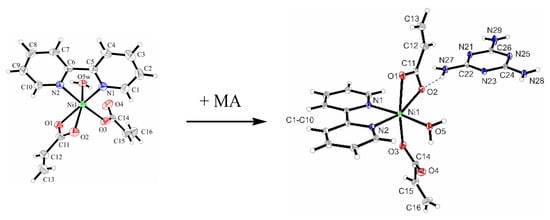
Scheme 1.
Synthesis of the new compound.
3.2. Complex Characterization
3.2.1. Description of the X-ray Crystal Structure of the Complex
A mixture in a 1:1 molar ratio of the complex compound [Ni(bpy)(acr)2(H2O)] and melamine led to the isolated co-crystal 1 [Ni(bpy)(acr)2(H2O)]·MA. This compound crystallized in the monoclinic space group C2/c with a distorted octahedral geometry of the central nickel(II) ion. The nickel cation is coordinated by two N atoms from a 2,2′-bipyridine ligand, two O atoms from a chelating carboxylate group, one terminal O atom from a second carboxylate group and one O atom from a water molecule. The co-crystalized melamine ligand interacts with the nickel-complex molecule through intermolecular N-H…O and O-H…N hydrogen bonds.
In contrast to the precursor [Ni(bpy)(acr)2(H2O)] [28], the coordinated water molecule occupied, in co-crystal 1, an equatorial position of the distorted octahedral geometry around the Ni(II) ion. The two Ni-N distances were found to be similar [Ni-N1 2.059(1) Å and Ni-N2 2.049(2) Å], whereas the Ni-O distances are different between the chelating carboxylate group [Ni-O1 2.131(1) Å and Ni-O2 2.148(2) Å], the unidentate carboxylate group and the water molecule, respectively [Ni-O3 2.069(1) Å and Ni-O5 2.061(1) Å]. Further details of the crystal parameters, data collection and refinement for complexes are summarized in Supplementary Table S1.
In the precursor and similar species with copper(II) [28], the two acrylate ion are coordinated in a similar fashion, one unidentate and one chelate, in cis positions. As results of supplementary interactions induced by melamine, their arrangement is changed to trans in complex 1.
The packing diagram of the co-crystal 1 presents a complex hydrogen bonds network between the coordinated carboxylate groups, water molecules and the melamine molecules. Linear chains of alternating dimeric type involving the nickel complex units and melamine molecules were observed perpendicular to the ac-diagonal (Figure 1) [(i) N27-H27A…O2 2.239(2) Å and 159.5(2)°; (ii) N29-H29A…O2 2.181(2) Å and 144(2)°; and (iii) O5-H01…N25 1.970(3) Å and 170(2)°].
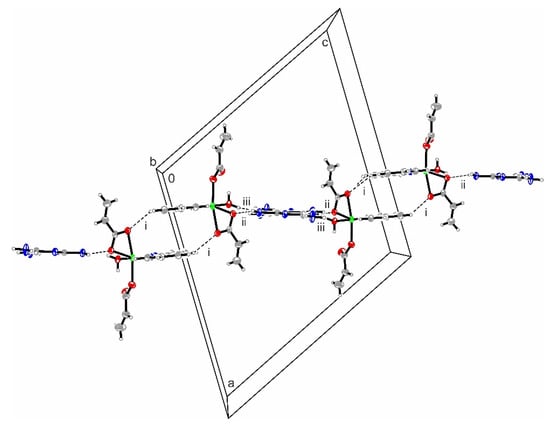
Figure 1.
Excerpt of the packing diagram of co-crystal 1 representing the interactions between the nickel complex and the melamine molecules perpendicular to the ac-diagonal.
The dimeric units between the nickel complex molecules are formed by two types of interactions: C-H…O hydrogen bonds between the aromatic bipyridine ligand and one carboxylate group [C4-H4…O1 2.633(2) Å and 149(2)°; C7-H7…O1 2.450(2) Å and 145(2)° (Figure 1)], and π…π interactions between two adjacent bipyridyl groups (shortest distance between the aromatic ligands: C2…C3 3.525 Å). Intermolecular N-H…N hydrogen bonds between the melamine ligands were found along the b-axis [N28-H28A…N21 2.348(2) Å and 179(2)°; N29-H29B…N23 2.052(2) Å and 170(2)°] (Figure 2).
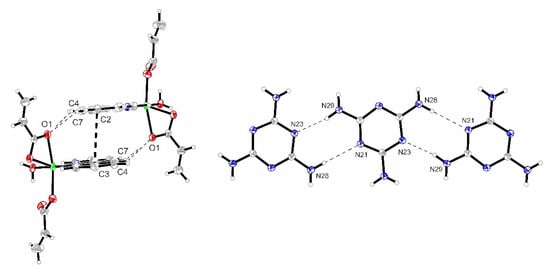
Figure 2.
Dimer type formation between two complex molecules involving C-H…O and π…π interactions (left), and linear chains formation along the b-axis through N-H…N hydrogen bonds interactions between the melamine ligands (right).
Additional π…π interactions with a partial overlapping between bipyridyl units and the melamine ligands (the shortest distance between the aromatic rings: C4…C22 3.311 Å and C9…C24 3.278 Å) were observed (Supplementary Table S1).
The Ni-N bond lengths identified in the case of the new synthesized compound are slightly smaller than those measured for precursor complex; meanwhile, Ni-O distances from chelating acrylate are quite similar [27]. Additionally, Ni-N and Ni-O bond lengths for similar complexes with mixed ligands fall in the same range (Table 1).

Table 1.
Comparison of bond lengths (Å) for co-crystal complex and similar carboxylate species.
3.2.2. Infrared Spectra
The IR spectra both for the raw materials and for the obtained compound were compared in order to establish the nature of ligands and their coordination mode. Thus, the spectrum of [Ni(bpy)(acr)2(H2O)]·MA contains all bands of the starting complex [Ni(bpy)(acr)2(H2O)] at the same wavenumbers (Figure 3), indicating that the coordination mode of ligands is unaltered. Furthermore, in the 3100–3400 cm−1 range there appears to be characteristic bands for melamine (νas(NH2), νs(NH2)) [39,40].
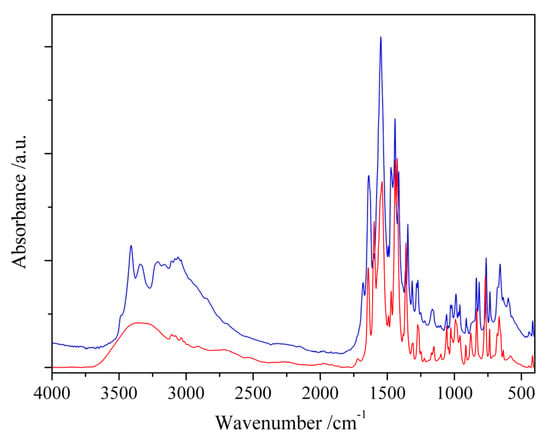
Figure 3.
IR spectra of [Ni(bpy)(acr)2(H2O)] (red) and [Ni(bpy)(acr)2(H2O)]·MA (blue).
3.2.3. UV-Vis-NIR Spectra
The UV-Vis-NIR spectrum of [Ni(bpy)(acr)2(H2O)]·MA is consistent with an octahedral stereochemistry for nickel(II) ion (Figure 4). This contains all three spin-allowed bands assigned to transitions 3A2g → 3T2g (1030 nm), 3A2g → 3T1g (635 nm) and 3A2g → 3T1g(P) (370 nm), and one spin-forbidden band assigned to 3A2g → 1Eg (760 nm) [41].
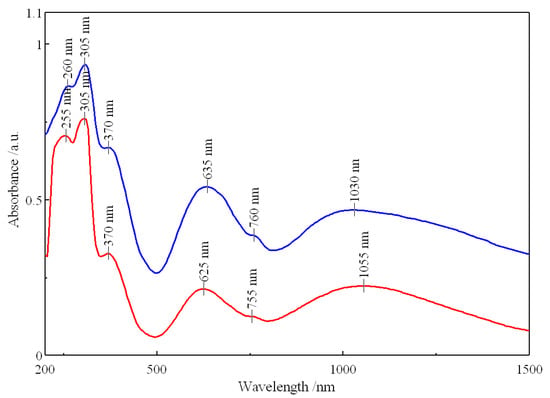
Figure 4.
UV-Vis-NIR spectra of [Ni(bpy)(acr)2(H2O)]·MA (blue) and [Ni(bpy)(acr)2(H2O)] (red).
The spectrum of 1 is slightly different from that of the precursor concerning the bands corresponding to the spin-allowed transitions 3A2g → 3T2g (1055 nm) and 3A2g → 3T1g (625 nm), as well as the spin-forbidden transition 3A2g → 1Eg (755 nm) [25]. This comes from the different ligand arrangement, bond lengths and angles, which are all induced by interaction with MA.
3.2.4. Thermal Behavior
Dynamic thermogravimetric measurement (TG) in air showed (Figure 5) that the complex 1 [Ni(bpy)(acr)2(H2O)] MA is thermally stable up to 108 °C, followed by dehydration up to 168 °C; this is seen as a weak endothermic effect on the DSC curve. The temperature range of mass loss was determined by the first derivative of the TG curve (DTG curve). In the second step, the fission of the two acrylate ions is monitored for the next 100 °C. The decomposition is sequential, since at 215 °C the slope on the TG curve changes, as could be seen as a shoulder on the DTG curve and a ratio of 7.9: 16.6% weight loss, which is about 1: 2, proving the two different coordination modes of the acrylate ion, which is consistent with the crystal structure (Scheme 1). The evolution of the gaseous products is shown on the TG–MS curve (Figure 6), where in the temperature range between 168–268 °C the signals typical of the acrylate ion and its rich fragmentation appear (m/z = 72, 55, 44, 53 and 58, 56, 52 not shown here) in accordance with database of the National Institute of Standards and Technology (NIST) [42]. The temperature interval of mass loss of the two acrylate ligands is consistent with the TG observations of the cobalt(II)-melamine complex, which otherwise contains no bpy ligand [17].
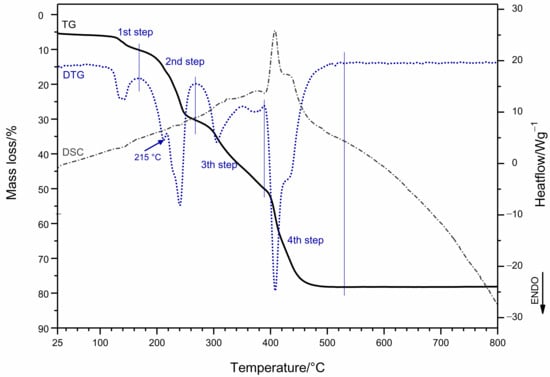
Figure 5.
TG (black line), DSC (black dot line) and DTG (blue dot line) curves in air of compound 1.

Figure 6.
TG-MS curves in air of compound 1.
In the temperature range between 268 and 529 °C, the main weight loss occurs in the form of two exothermic effects.
The TG-MS curve in third step shows peaks (m/z = 78, 51, 55, 53, and 54, 52, 41 not shown here) indicating the decomposition of bipyridine [43], whereas in fourth step, above 385 °C, only CO2, NO, NO2 and water (m/z = 44, 30, 48, 18) are detected as end products of the strongly oxidative combustion of melamine and charred organic residue. The decomposition of organic ligands is accompanied by released water (m/z = 18) and carbon dioxide (m/z = 44) in all steps.
Melamine is rich in nitrogen and has also fire-retardant properties, as it releases nitrogen gas during combustion [44]. At the very high temperature, the reaction between oxygen and nitrogen in the air to form nitric oxide (m/z = 30) is thermodynamically favorable (N2 + O2 ⟶ 2NO), and the nitric oxide reacts very rapidly with further oxygen to form nitrogen dioxide (m/z = 46) (NO + O2 ⟶ NO2). As soon as melted MA (melting point 343 °C) starts to release nitrogen [45], it inhibits the complete oxidative degradation of the bipyridine or causes its carbonization. Only at higher temperatures does the retention effect diminish, and it burns in air to a residue containing neither organic phase nor carbon (dark grey NiO). For this reason, the experimental values do not agree with the theoretical mass losses for each compound in each temperature range (Table 2), but the sum of the last two steps agrees well with the structure: experimentally 57.6 and theoretically 56.7%.

Table 2.
Thermal decomposition data (in air flow) for co-crystal.
Compared with the thermal decomposition of the nickel(II) precursor [46], the additional ligand, MA, predictably caused an additional step in mass loss, but the order of release of first the acrylate ligand and then the bpy ligand remained the same. Because the heating rate was half reduced (5 K min−1), the steps shifted to lower temperatures.
3.2.5. Antimicrobial Assay
The quantitative MIC assay revealed that, among the tested bacterial strains, Staphylococcus aureus was the most susceptible, followed by Enterococcus faecalis and Pseudomonas aeruginosa. The obtained complex 1 revealed a similar activity with that of the precursor complex in the case of three of the four tested strains, excepting Enterococcus faecalis, when the MIC values are expressed in mg/mL units. When we are looking at CMI values in mM units, it is obvious that, except E. faecalis, complex 1 is more active than its precursor. This can be interpreted that MA reduces the amount of active species that produce the same antimicrobial effect. In three of the four cases, the new complex and the starting complex exhibited higher antibacterial activity than MA (Table 3), whereas in the case of P. aeruginosa, the efficiency of the three tested compounds was similar. The nickel(II) complex without MA proved to be more active against the four tested bacterial strains, as compared with other nickel(II) complexes reporting MIC values of 0.625–10 mg/mL against similar species [47] or >0.1 mg/mL against S. aureus [48]. The MIC values obtained for the tested compounds were much higher than those obtained for the gentamycin antibiotic control. However, it must be taken into account that these compounds are not yet standardized regarding their solubility and stability in organic environments, and their mechanism of action is not yet established; therefore, the recorded in vitro differences cannot be extrapolated to their efficiency as potential antimicrobial agents.

Table 3.
The MIC values [(mg/mL/mM)] of the tested compounds.
The anti-biofilm activity of the tested compounds was investigated through the microtiter assay, allowing us to establish the MBEC value. The obtained results show that the range of MBEC values (0.15 to 1.25 mg/mL) was very close to that of the MIC values (0.07 to 1.25 mg/mL). This demonstrates the potential of these complexes to develop novel anti-biofilms agents. Similar to the MIC assays, both the complexes exhibited a better anti-biofilm effect as compared to MA. The only case in which anti-biofilm activity of the complex was not improved, but on the contrary was less intense than that of the raw MA, was the Pseudomonas aeruginosa strain. The two Gram-positive strains proved to be more susceptible to the tested complexes compared to the Gram-negative ones (Table 4). This could be explained by the different structure of the cellular envelopes. Although the peptidoglycan layer of the Gram-negative bacteria is thinner than that of the Gram-positive ones, the first ones have an additional barrier, represented by the outer membrane, which is permeable only through the porins way, allowing the internalization of polar, hydrophilic molecules with a molecular weight lower than 600 Da. Moreover, the molecule charge is equally important, the positively charged molecules accumulating intracellularly more efficiently than the neutral or negatively charged molecules [48,49].

Table 4.
The MBEC values [(mg/mL)/mM)] of the tested compounds.
4. Conclusions
A new co-crystal, [Ni(bpy)(acr)2(H2O)]·MA, has been obtained starting from [Ni(bpy)(acr)2(H2O)] and melamine. Although the ligands have the same coordination modes as in raw material, the nickel ion environment undergoes a rearrangement, the water molecule being in an equatorial position in the new co-crystal. The melamine molecules are involved in hydrogen bonds with the coordinated carboxylate groups and water molecules.
The antimicrobial activity of the obtained complex, the precursor complex and melamine assessed against planktonic (MIC) and biofilm-embedded (MBEC) Gram-positive and Gram-negative bacterial strains revealed that the complex and its ligand exhibited a superior activity compared to MA. The Gram-positive strains proved to be more susceptible than the Gram-negative ones, the highest susceptibility being recorded for the Staphylococcus aureus strain. The MIC and MBEC ranges were very similar, indicating the potential of this complex and its precursor to develop novel anti-biofilm agents.
Supplementary Materials
The following are available online at https://www.mdpi.com/article/10.3390/cryst12081078/s1, Figure S1: Asymmetric unit of co-crystal 1. Thermal ellipsoids are shown at 15% probability, Figure S2: Dimer type formation between two Ni complexes molecules involving C-H…O and π…π interactions, Figure S3: Linear chains formation along b-axis through N-H…N hydrogen bonds interactions between the melamine ligands, Figure S4: Excerpt of the packing diagram of co-crystal 1 representing the interactions (i, ii, and iii) between the nickel complex and the melamine ligand perpendicular to the ac-diagonal Table S1: Non-covalent inter- and intramolecular interactions in co-crystal 1 (Å and deg).
Author Contributions
Conceptualization, R.O., M.C.C. and M.B.; data curation, G.V.S. and M.C.C., formal analysis, G.V.S., C.G.D., M.C.C., N.Č.K., R.C.K., R.O. and M.B.; investigation, G.V.S., C.G.D., M.C.C., N.Č.K., R.C.K., R.O. and M.B.; methodology, R.O. and M.C.C.; supervision, R.O. and M.B.; writing—original draft, G.V.S., C.G.D., M.C.C., N.Č.K. and M.B.; writing—review and editing, R.O., M.C.C. and M.B. All authors have read and agreed to the published version of the manuscript.
Funding
Slovenian authors acknowledge the financial support provided by the Slovenian Research Agency ARRS (research core funding No. P1-0134).
Institutional Review Board Statement
Not applicable.
Informed Consent Statement
Not applicable.
Data Availability Statement
The data presented in this study are available on request from the corresponding author.
Conflicts of Interest
The authors declare no conflict of interest.
References
- Refat, M.; Adam, A.M.; El-Sayed, M. Biomarkers charge-transfer complexes of melamine with quinol and picric acid: Synthesis, spectroscopic, thermal, kinetic and biological studies. Arab. J. Chem. 2017, 10, S3482–S3492. [Google Scholar] [CrossRef] [Green Version]
- Goodgame, D.; Hussain, I.; White, A.; Williams, D. Synthesis and structure of a copper(II) melamine complex [Cu(MA)(µ-OCH3)(ONO2)(CH3OH)]2, with direct Cu-melamine coordination. J. Chem. Soc. Dalton Trans. 1999, 17, 2899–2900. [Google Scholar] [CrossRef]
- Yu, Y.-Q.; Lu, C.-Z.; He, X.; Chen, S.-M.; Zhang, Q.-Z.; Chen, L.-J.; Yang, W.-B. Synthesis, structure and fluorescent property of a novel inorganic-organic zinc compound. J. Chem. Cryst. 2004, 34, 905–909. [Google Scholar] [CrossRef]
- Chen, C.; Yeh, C.W.; Chen, J.D. Syntheses, structures and thermal properties of two new copper(II) melamine complexes. Polyhedron 2006, 25, 1307–1312. [Google Scholar] [CrossRef]
- Zhang, L.; Li, W.; Zhang, J.; Li, Z.-J.; Qin, Y.-Y.; Cheng, J.-K.; Yao, Y.-G. Antiferromagnetic interactions in melamine-bridged trinuclear cobalt complex. Inorg. Chem. Commun. 2008, 11, 279–282. [Google Scholar] [CrossRef]
- Li, Y.-H.; Sun, D.; Luo, G.-G.; Liu, F.-J.; Hao, H.-J.; Wen, Y.-M.; Zhao, Y.; Huang, R.-B.; Zheng, L.-S. Two Ag(I) coordination polymers derived from melamine and dicarboxylates: Syntheses, crystal structures and thermal stabilities. J. Mol. Struct. 2011, 1000, 85–91. [Google Scholar] [CrossRef]
- Sivashankar, K.; Ranganathan, A.; Pedireddin, V.R.; Rao, C.N.R. Novel supramolecular organizations in melamine complexes with 4,4′-bipyridyl and silver nitrate. J. Mol. Struct. 2001, 559, 41–48. [Google Scholar] [CrossRef]
- Zhang, L.; Zhang, J.; Li, J.-L.; Cheng, J.-K.; Yin, P.-X.; Yao, Y.-G. New coordination motifs of melamine directed by N-H···X (X=Cl or Br) hydrogen bonds. Inorg. Chem. 2007, 46, 5838–5840. [Google Scholar] [CrossRef] [PubMed]
- Zhao, H.-Y.; Bai, F.-Y.; Xing, Y.-H.; Li, Z.-P.; Cao, Y.-Z.; Zeng, X.-Q.; Ge, M.-F. A melamine–adipate-bridged binuclear copper complex with supramolecular architecture: Synthesis, structures, and properties of [Cu2(MA)(ad)2]·H2O and (MA)·(H2ad)·H2O. J. Coord. Chem. 2010, 63, 435–447. [Google Scholar] [CrossRef]
- Rana, A.; Bera, M.; Choudhuri, D.S.; Hazari, D.; Jana, S.K.; Zangrando, E.; Dalai, S. 3D coordination network of Ag(I) ions with µ3-bridging melamine ligands. J. Inorg. Organomet. Polym. 2012, 22, 360–368. [Google Scholar] [CrossRef]
- Zhang, Y.; Chen, K.; Fan, H.-T. Synthesis, crystal structure and catalytic property of a new Cu(I) coordination polymer constructed from melamine and azide ligands. Inorg. Chem. Commun. 2013, 38, 47–49. [Google Scholar] [CrossRef]
- Ranganathan, A.; El-Ghayoury, A.; Zorina, L.; Batail, P. The layered topology of a five components melaminium-melamine hybrid salt of a functional gold (II) dithiolene complex. Cryst. Eng. Comm. 2010, 12, 4268–4274. [Google Scholar] [CrossRef] [Green Version]
- Iliopoulos, K.; El-Ghayoury, A.; Derkowska, B.; Ranganathan, A.; Batail, P.; Gindre, D.; Sahraoui, B. Effect of the counter cation on the third order nonlinearity in anionic Au dithiolene complexes. Appl. Phys. Lett. 2012, 101, 261105. [Google Scholar] [CrossRef] [Green Version]
- Mirzaei, M.; Eshtiagh-Hosseini, H.; Bazargan, M. Syntheses and X-ray crystal structure studies of four new coordination complexes and salts based on proton-transferred pyridine-2,6-dicarboxylic acid N-oxide. Res. Chem. Intermed. 2015, 41, 9785–9803. [Google Scholar] [CrossRef]
- Mitra, M.; Hossain, A.; Manna, P.; Choudhury, S.R.; Kaenket, S.; Helliwell, M.; Bauzá, A.; Frontera, A.; Mukhopadhyay, S. Melamine-mediated self-assembly of a Cu(II)–methylmalonate complex assisted by π+–π+ and anti-electrostatic H-bonding interactions. J. Coord. Chem. 2017, 70, 463–474. [Google Scholar] [CrossRef]
- Krichen, F.; Walha, S.; Lhoste, J.; Bulou, A.; Hemon-Ribaud, A.; Goutenoire, F.; Kabadou, A. Supramolecular and heterometallic architectures based on [Fe(CN)6]3− metallotectons and diverse organic cations: Crystal structure, Hirshfeld surface analysis, spectroscopic and thermal properties. Inorg. Chim. Acta 2019, 486, 36–47. [Google Scholar] [CrossRef]
- Olar, R.; Scăețeanu Vasile, G.; Dănilă, M.; Daniliuc, C.-G.; Cerc Korošec, R.; Celan Korošin, N.; Badea, M.J. Synthesis and characterization of cobalt acrylate-melamine co-crystals. J. Therm. Anal. Calorim. 2019, 135, 2257–2264. [Google Scholar] [CrossRef]
- Liu, H.; Zhi, W.-W.; Liu, X.-Z. Two New Zn(II)/Cd(II) Complexes: Luminescent Properties and Treatment Activity on Cardiovascular Disease. J. Fluoresc. 2022, in press. [CrossRef]
- Vírseda, I.B.; Siddiqui, S.A.; Prado-Roller, A.; Eisterer, M.; Shiozawa, H. Crystal engineering with copper and melamine. RSC Adv. 2021, 11, 23943. [Google Scholar] [CrossRef]
- Chen, L.-D.; Zhou, L.-X.; Zheng, Y.-Q.; Zhu, H.-L. Two new Ag(I) supramolecular complexes based on melamine: Synthesis, structures and photocatalytic activity under visible light irradiation. Polyhedron 2017, 18, 150–158. [Google Scholar] [CrossRef]
- Baraka, A.; Hatem, H.; El-Geundi, M.S.; Tantawy, H.; Karaghiosoff, K.; Gobara, M.; Elbeih, A.; Shoaib, M.; Elsayed, M.A.; Kotb, M.M. A new cationic silver(I)/melamine coordination polymer, [Ag2(melamine)]2+: Synthesis, characterization and potential use for aqueous contaminant anion exchange. J. Solid State Chem. 2019, 274, 168–175. [Google Scholar] [CrossRef]
- Mastalir, M.; Kirchner, K. A triazine-based Ni(II) PNP pincer complex as catalyst for Kumada-Corriu and Negishi cross-coupling reactions. Monatsch. Chem. 2017, 148, 105–109. [Google Scholar] [CrossRef] [PubMed] [Green Version]
- Elsharkawy, R.G. Incorporation of copper/melamine complexes in silica surface and their sorption activity of organic dye. Iran. J. Chem. Chem. Eng. 2017, 36, 99–114. [Google Scholar]
- Zorainy, M.; Boffito, D.; Gobara, M.; Baraka, A.; Naeem, I.; Tantawy, H. Synthesis of a novel Ce(III)/melamine coordination polymer and its application for corrosion protection of AA2024 in NaCl solution. RSC Adv. 2021, 11, 6330–6345. [Google Scholar] [CrossRef] [PubMed]
- Olar, R.; Badea, M.; Marinescu, D.; Mardale, R. Thermal behaviour of new Cu(II) complexes with Schiff bases functionalised with 1,3,5-triazine moieties as potential antibacterial agents. J. Therm. Anal. Calorim. 2011, 105, 553–557. [Google Scholar] [CrossRef]
- Zhu, H.; Zhang, S.; Li, M.; Shao, Y.; Zhu, Z. Electrochemical sensor for melamine based on its complex. Chem. Commun. 2010, 46, 2259–2261. [Google Scholar] [CrossRef]
- Scăețeanu Vasile, G.; Chifiriuc, M.C.; Bleotu, C.; Karmezan, C.; Măruțescu, L.; Daniliuc, C.-G.; Maxim, C.; Calu, L.; Badea, M. Synthesis, Structural Characterization, Antimicrobial Activity, and In Vitro Biocompatibility of New Unsaturated Carboxylate Complexes with 2,2′-Bipyridine. Molecules 2018, 23, 157. [Google Scholar] [CrossRef] [PubMed] [Green Version]
- Hooft, R.W.W.; Nonius, B.V. COLLECT, Program for Collecting Data on CCD Area Detectors; Bruker AXS: Delft, The Netherlands, 1998. [Google Scholar]
- Otwinowski, Z.; Minor, W. Processing of X-ray diffraction data collected in oscillation mode. Meth. Enzymol. 1997, 276, 307–326. [Google Scholar]
- Otwinowski, Z.; Borek, D.; Majewski, W.; Minor, W. Multiparametric scaling of diffraction intensities. Acta Crystallogr. A 2003, 59, 228–234. [Google Scholar] [CrossRef] [PubMed]
- Sheldrick, G.M. SHELXT—Integrated space-group and crystal-structure determination. Acta Crystallogr. 2015, A71, 3–8. [Google Scholar] [CrossRef] [Green Version]
- Sheldrick, G.M. Crystal structure refinement with SHELXL. Acta Crystallogr. 2015, C71, 3–8. [Google Scholar]
- Bruker AXS Inc. XP—Interactive Molecular Graphics, Version 5.1; Bruker AXS Inc.: Madison, WI, USA, 1998.
- Chifiriuc, M.C.; Grumezescu, A.M.; Andronescu, E.; Ficai, A.; Cotar, A.I.; Grumezescu, V.; Bezirtzoglou, E.; Lazar, V.; Radulescu, R. Water dispersible magnetite nanoparticles influence the efficacy of antibiotics against planktonic and biofilm embedded Enterococcus faecalis cells. Anaerobe 2013, 22, 14–19. [Google Scholar] [CrossRef]
- Gingasu, D.; Mindru, I.; Mocioiu, O.C.; Preda, S.; Stanica, N.; Patron, L.; Ianculescu, A.; Oprea, O.; Nita, S.; Paraschiv, I.; et al. Synthesis of nanocrystalline cobalt ferrite through soft chemistry methods: A green chemistry approach using sesame seed extract. Mater. Chem. Phys. 2016, 182, 219–230. [Google Scholar] [CrossRef]
- Ye, B.-H.; Chen, X.-M.; Xue, G.-Q.; Li, L.N. Mononuclear nickel complexes assembled into two-dimensional networks via hydrogen bonds and π-π stacking interactions. J. Chem. Soc. Dalton Trans. 1998, 17, 2827–2832. [Google Scholar] [CrossRef]
- Begum, R.; Rehman, M.; Shahid, K.; Iqbal, M.; Tahir, M.N.; Ali, S. Synthesis, structural elucidation, DNA-binding and biological activity of nickel (II) mixed ligand carboxylate complexes. J. Mol. Struct. 2021, 1242, 130801. [Google Scholar] [CrossRef]
- Krešáková, L.; Miňo, A.; Holum, M.; Kuchár, J.; Werner, A.; Tomás, M.; Čižmár, E.; Falvello, L.; Černák, J. Heteroleptic complexes of Ni(II) with 2,2′-bipyridine and benzoato ligands. Magnetic properties of [Ni(bpy)(Bz)2]. Inorg. Chim. Acta 2021, 527, 120588. [Google Scholar] [CrossRef]
- Gunasekaran, S.; Srinivasan, K.; Xavier Jesu Raja, S. Fourier transform infrared and laser Raman scattering studies on the structure of melamine. Proc. Indian Natl. Sci. Acad. 1993, 59, 347–352. [Google Scholar]
- Mircescu, N.E.; Oltean, V.; Chis, V.; Leopold, N. FTIR, FT-Raman, SERS and DFT study on melamine. Vib. Spectrosc. 2012, 62, 165–171. [Google Scholar] [CrossRef]
- Lever, A.B.P. Inorganic Electronic Spectroscopy, 2nd ed.; Elsevier: Amsterdam, The Netherlands; London, UK; New York, NY, USA, 1984; pp. 507–544. [Google Scholar]
- 1,3,5-Triazine-2,4,6-triamine. Available online: https://webbook.nist.gov/cgi/cbook.cgi?ID=C108781&Units=SI&Mask=200#Mass-Spec (accessed on 19 June 2022).
- 2,2′-Bipyridine. Available online: https://webbook.nist.gov/cgi/cbook.cgi?ID=C366187&Units=SI&Mask=200#Mass-Spec (accessed on 19 June 2022).
- Melamine —Flame Retardants. Available online: http://fr.polymerinsights.com/fr-types/nitrogen-based/melamine (accessed on 19 June 2022).
- Haynes, W.M. (Ed.) CRC Handbook of Chemistry and Physics, 92nd ed.; CRC Press: Boca Raton, Fl, USA, 2011; p. 3516. [Google Scholar]
- Badea, M.; Olar, R.; Marinescu, D.; Vasile, G. Thermal behavior of some new complexes bearing ligands with polymerisable groups. J. Therm. Anal. Calorim. 2006, 85, 285–288. [Google Scholar] [CrossRef]
- Sheikhshoaie, I.; Lotfi, N.; Sieler, J.; Krautscheid, H.; Khaleghi, M. Synthesis, structures and antimicrobial activities of nickel(II) and zinc(II) diaminomaleonitrile-based complexes. Trans. Met. Chem. 2018, 43, 555–562. [Google Scholar] [CrossRef] [Green Version]
- Podda, E.; Arca, M.; Atzeni, G.; Coles, S.J.; Ibba, A.; Isaia, F.; Lippolis, V.; Orrù, G.J.; Orton, B.; Pintus, A.; et al. Antibacterial Activity of Amidodithiophosphonato Nickel(II) Complexes: An Experimental and Theoretical Approach. Molecules 2020, 25, 2052. [Google Scholar] [CrossRef] [PubMed]
- Jones, S. Permeability rules for antibiotic design. Nat. Biotechnol. 2017, 35, 639. [Google Scholar] [CrossRef] [PubMed]
Publisher’s Note: MDPI stays neutral with regard to jurisdictional claims in published maps and institutional affiliations. |
© 2022 by the authors. Licensee MDPI, Basel, Switzerland. This article is an open access article distributed under the terms and conditions of the Creative Commons Attribution (CC BY) license (https://creativecommons.org/licenses/by/4.0/).